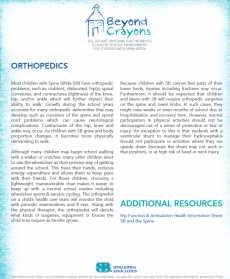Most children with Spina Bifida have orthopedic problems.
Most children with Spina Bifida (SB) have orthopedic problems, such as clubfoot, dislocated, hip(s), spinal curvatures, and contractures (tightness) of the knee, hip, and/or ankle which will further impact their ability to walk. Growth during the school years accounts for many orthopedic deformities that may develop such as curvature of the spine and spinal cord problems which can cause neurological complications. Contractures of the hip, knee, and ankle may occur. As children with SB grow and body proportion changes, it becomes more physically demanding to walk.
Although many children may begin school walking with a walker or crutches, many older children elect to use the wheelchair as their primary way of getting around the school. This frees their hands, reduces energy expenditure and allows them to keep pace with their friends. For those children, choosing a lightweight, maneuverable chair makes it easier to keep up with a normal school routine including wheelchair sports & aerobic cycling. The orthopedist on a child’s health care team will monitor the child with periodic examinations and X-rays. Along with the physical therapist, the orthopedist, will decide what kinds of surgeries, equipment or braces the child may require as he/she grows.
Because may children with SB cannot feel parts of their lower body, injuries including fractures may occur. Furthermore, it should be expected that children and teens with SB will require orthopedic surgeries on the spine and lower limbs. In such cases, they might miss weeks or even months of school due to hospitalization and recovery time. However, normal participation in physical activities should not be discouraged out of a sense of protection or fear of injury. An exception to this is that students with a ventricular shunt to manage their hydrocephalus should not participate in activities where they are upside down (because the shunt may not work in that position), or at high risk of head or neck injury.
This information does not constitute medical advice for any individual. As specific cases may vary from the general information presented here, SBA advises readers to consult a qualified medical or other professionals on an individual basis.
Tags



